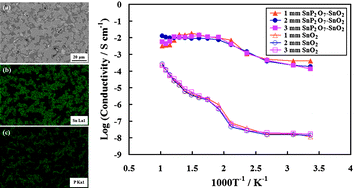Synthesis and characterization of dense SnP2O7–SnO2 composite ceramics as intermediate-temperature proton conductors
Abstract
Dense

* Corresponding authors
a
Graduate School of Environmental Studies, Nagoya University, Chikusa-ku, Nagoya, Japan
E-mail:
hibino@urban.env.nagoya-u.ac.jp
Fax: +81 52 789 4894
b Research Institute Instrumentation Frontier, National Institute of Advanced Industrial Science and Technology, Moriyama-ku, Nagoya, Japan
Dense

 Please wait while we load your content...
Something went wrong. Try again?
Please wait while we load your content...
Something went wrong. Try again?
Y. Shen, M. Nishida, W. Kanematsu and T. Hibino, J. Mater. Chem., 2011, 21, 663 DOI: 10.1039/C0JM02596H
To request permission to reproduce material from this article, please go to the Copyright Clearance Center request page.
If you are an author contributing to an RSC publication, you do not need to request permission provided correct acknowledgement is given.
If you are the author of this article, you do not need to request permission to reproduce figures and diagrams provided correct acknowledgement is given. If you want to reproduce the whole article in a third-party publication (excluding your thesis/dissertation for which permission is not required) please go to the Copyright Clearance Center request page.
Read more about how to correctly acknowledge RSC content.
 Fetching data from CrossRef.
Fetching data from CrossRef.
This may take some time to load.
Loading related content
